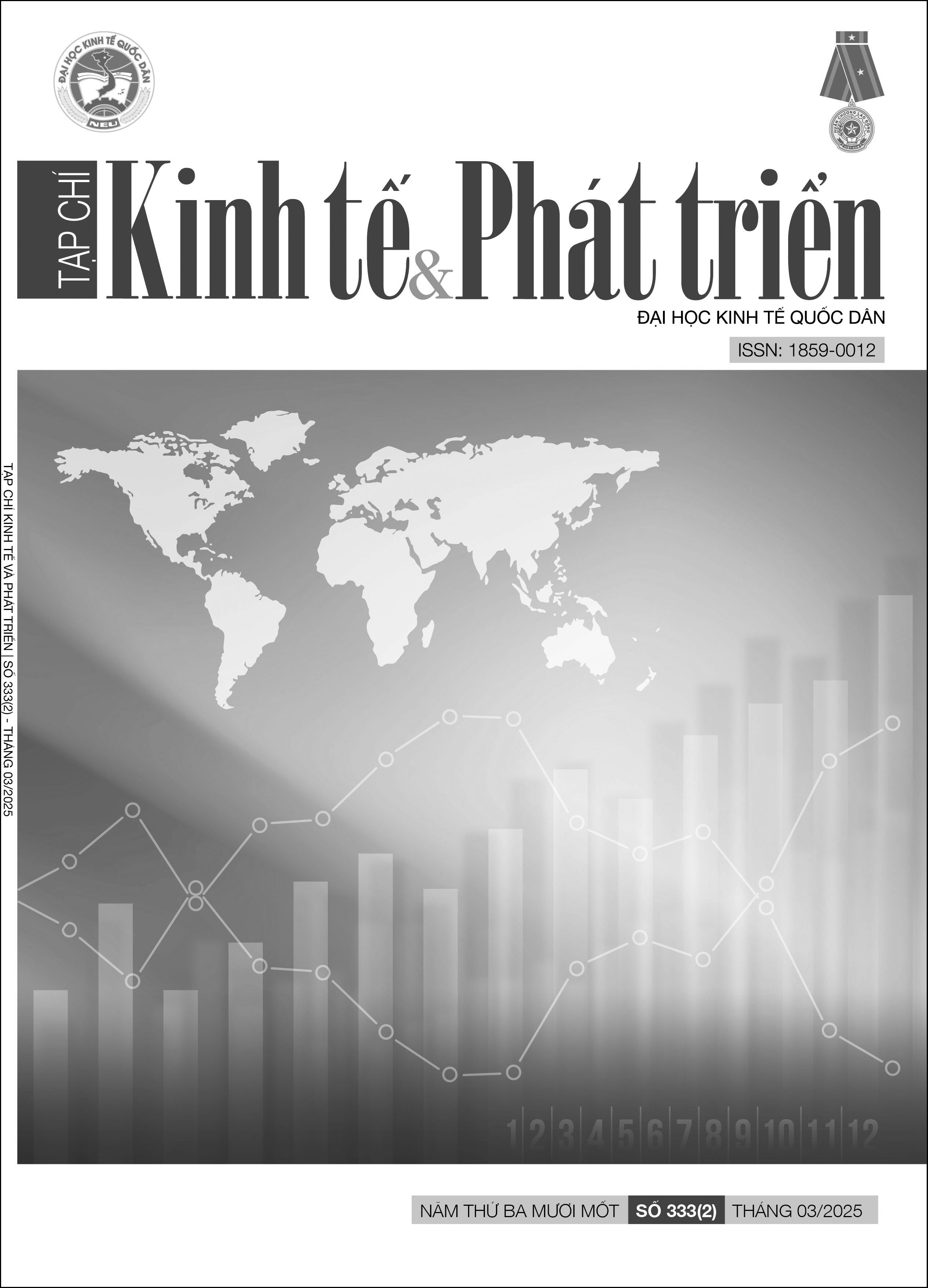Các cơ hội áp dụng kinh tế tuần hoàn trong chuỗi giá trị lúa gạo ở Việt Nam
DOI:
https://doi.org/10.33301/JED.VI.2177Từ khóa:
chuỗi giá trị, chuỗi giá trị lúa gạo tuần hoàn, kinh tế tuần hoànTóm tắt
Sử dụng số liệu thứ cấp kết hợp với phương pháp thảo luận nhóm tập trung, bài viết này áp dụng các nguyên tắc của kinh tế tuần hoàn vào phân tích chuỗi giá trị lúa gạo ở Việt Nam. Bài viết chỉ ra rằng một lượng lớn chất thải/phụ phẩm được tạo ra dọc theo chuỗi giá trị từ sản xuất lúa, thu hoạch và chế biến gạo ở Việt Nam. Đẩy mạnh các mô hình kinh tế tuần hoàn từ rơm, các giải pháp chế biến phụ phẩm theo hướng tăng giá trị gia tăng và thiết kế, sản xuất bao bì sử dụng các vật liệu thân thiện với môi trường sẽ tạo ra các cơ hội gia tăng giá trị dọc theo chuỗi lúa gạo ở Việt Nam. Các chính sách hỗ trợ từ nhà nước đóng vai trò quan trọng, bao gồm nghiên cứu phát triển và ứng dụng khoa học công nghệ, chuyển giao công nghệ, phát triển thị trường đầu ra cho sản phẩm, khuyến khích/ưu đãi đầu tư và truyền thông nâng cao nhận thức về tái sử dụng, tái chế và xử lý phế phụ phẩm từ sản xuất lúa gạo.
Tài liệu tham khảo
Eisenreich, A., Füller, J., Stuchtey, M. & Jimenez, D.G. (2022). Toward a Circular Value Chain: Impact of the Circular Economy on a Company's Value Chain Processes. Journal of Cleaner Production, 378 (2022), 134375. 10.1016/j.jclepro.2022.134375.
Gillai, B. (2022). The Road Toward a Circular Value Chain. Retrieved Nov 30, 2024, from https://www.gsb.stanford.edu/faculty-research/publications/road-toward-circular-value-chain.
Bộ Nông nghiệp và Phát triển Nông thôn (2024), Niên giám thống kê ngành nông nghiệp và phát triển nông thôn 2023, Nhà xuất bản Nông nghiệp, Hà Nội.
Miller, C. & Jones, L. (2010). Agricultural Value Chain Finance: Tools and Lessons. Food and Agriculture Organization of the United Nations, Rome.
Dao The Anh, Thai Van Tinh, & Nguyen Ngoc Vang (2020). The Domestic Rice Value Chain in the Mekong Delta. in Cramb, R. (ed), White Gold: The Commercialisation of Rice Farming in the Lower Mekong Basin. 10.1007/978-981-15-0998-8_18.
Neven, D. (2014). Developing Sustainable Food Value Chain: Guiding Principles. Food and Agriculture Organization of the United Nations, Rome.
Ellen Macarthur Foundation (2013). Towards the Circular Economy. Retrieved Nov 30, 2024, from https://www.aquafil.com/assets/uploads/ellen-macarthur-foundation.pdf.
Ellen MacArthur Foundation (2019). Completing the Picture: How the Circular Economy Tackles Climate Change. Retrieved Nov 30, 2024, from www.ellenmacarthurfoundation.org/publications.
FAO (2023). Gross Domestic Product and Agriculture Value Added 2012–2021. Global and Regional Trends, FAOSTAT Analytical Briefs Series No. 64. Rome. 10.4060/cc5253en.
Bianchi, F., Beek, C., Winter, D. & Lammers, E. (2020). Opportunities and Barriers of Circular Agriculture. Food and Business Knowledge Platform, the Netherlands.
IPCC (2021). Summary for Policymakers. In Climate Change 2021: The Physical Science Basis. Cambridge University Press, Cambridge, United Kingdom and New York, 3−32. 10.1017/9781009157896.001.
Illankoon, W.A.M.A.N., Milanese, C., Collivignarelli, M.C. & Sorlini, S. (2022). Value Chain Analysis of Rice Industry by Products in a Circular Economy Context: A Review. Waste, 1, 333–369. 10.3390/waste1020022.
IRRI (2024). Kinh tế tuần hoàn từ rơm – Cải thiện thu nhập và phát triển bền vững. Dự án RiceEco, Thành phố Hồ Chí Minh.
Santana, K.D., Pereira, L.B.S., Cossío, N.S., Santos, H.B., Galván, F.S. & Cedeño, S.M.R. (2022). Evaluation of the Circular Economy in a Pitahaya Agri-Food Chain. Sustainability, 14(5), 1-17. 10.3390/su14052950.
Loc, V.T.T. (2016). Assessment of Agri-product Value Chains in the Mekong Delta: Problems and Solutions. Can Tho University Journal of Science, 2(2016), 100-111. 10.22144/ctu.jen.2016.001.
Material Economics (2018). The Circular Economy: A Powerful Force for Climate Mitigation. Retrieved Nov 30, 2024, from https://materialeconomics.com/publications/the-circular-economy-a-powerful-force-for-climate-mitigation-1.
Miranda, B.V., Monteiro, G.F. A., & Rodrigues, V.P. (2021). Circular Agri-food Systems: A Governance Perspective for the Analysis of Sustainable Agri-food Value Chains. Technological Forecasting and Social Change, 170(C). 10.1016/j.techfore.2021.120878.
World Bank (2024). Agriculture and Food. Retrieved Nov 30, 2024, from https://www.worldbank.org/en/topic/agriculture/overview.
Porter, Michael E. (1985). Competitive Advantage: Creating and Sustaining Superior Performance. Simon and Schuster, New York.
UNEP (2024). Global Resource Outlook 2024. Retrieved Nov 30, 2024, from https://www.unep.org/resources/Global-Resource-Outlook-2024.
United Nations (2021). Circular Agriculture for Sustainable Rural Development. Retrieved Nov 30, 2024, from https://www.un.org/development/desa/dpad/wp-content/uploads/sites/45/publication/PB_105.pdf.
Viện Chính sách và Chiến lược Phát triển nông nghiệp, Nông thôn (2023). Đề xuất chính sách thu hút đầu tư vào sử dụng nguyên liệu phế phụ phẩm nông nghiệp để phát triển kinh tế tuần hoàn trong nông nghiệp. Tóm tắt chính sách, Hà Nội.





